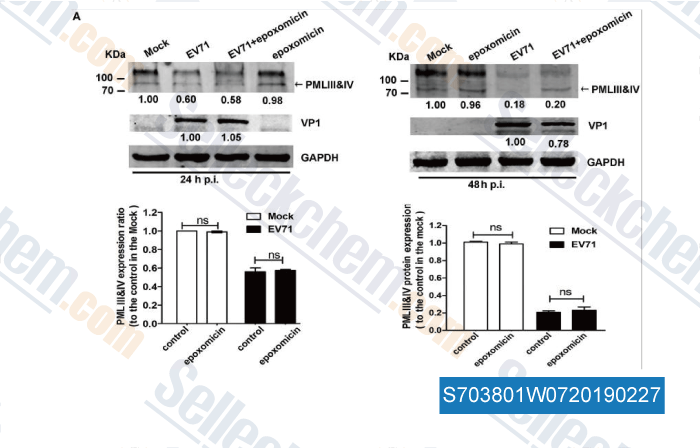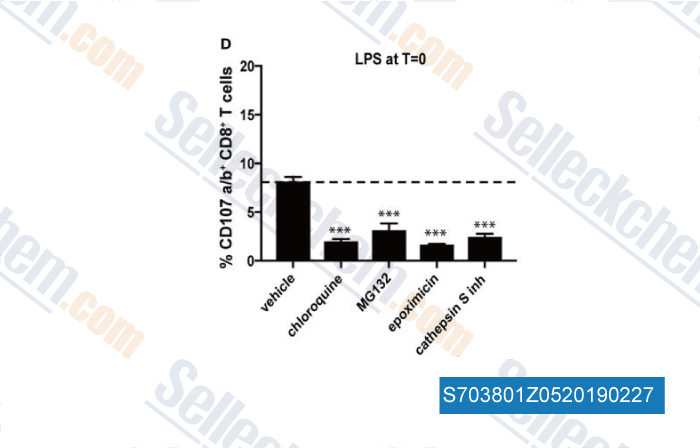|
Toll Free: (877) 796-6397 -- USA and Canada only -- |
Fax: +1-832-582-8590 Orders: +1-832-582-8158 |
Tech Support: +1-832-582-8158 Ext:3 Please provide your Order Number in the email. |
Technical Data
| Formula | C28H50N4O7 |
||||||
| Molecular Weight | 554.72 | CAS No. | 134381-21-8 | ||||
| Solubility (25°C)* | In vitro | DMSO | 100 mg/mL (180.27 mM) | ||||
| Ethanol | 100 mg/mL (180.27 mM) | ||||||
| Water | Insoluble | ||||||
| In vivo (Add solvents to the product individually and in order) |
|
||||||
|
* <1 mg/ml means slightly soluble or insoluble. * Please note that Selleck tests the solubility of all compounds in-house, and the actual solubility may differ slightly from published values. This is normal and is due to slight batch-to-batch variations. * Room temperature shipping (Stability testing shows this product can be shipped without any cooling measures.) |
|||||||
Preparing Stock Solutions
Biological Activity
| Description | Epoxomicin (BU-4061T, Aids010837) is a selective proteasome inhibitor with anti-inflammatory activity, inhibits primarily the CH-L activity of the 20S proteasome, while T-L and PGPH catalytic activities are also inhibited at 100- and 1000-fold reduced rate. Epoxomicin promotes apoptosis.Epoxomicin (BU-4061T) can be used to induce animal models of Parkinson's Disease. | |
|---|---|---|
| Targets |
|
|
| In vitro | Epoxomicin covalently binds to the LMP7, X, MECL1, and Z catalytic subunits of the proteasome. Epoxomicin (100 nM) results in a 30-fold increase in the levels of p53 protein, a known target of the proteasome, in HUVECs. Epoxomicin (10 μM) results in the accumulation of ubiquitinated proteins in HeLa cells. Epoxomicin (10 μM) inhibits IκBα degradation by 10-fold in HeLa cells. Epoxomicin (10 μM) produces a significant dose-dependent reduction in TNF-α-stimulated NF-κB DNA-binding activity in HeLa cells. [1] Epoxomicin inhibits proliferating of EL4 lymphoma cells with biotinylated chimerae with IC50 of 4 nM. [2] Epoxomicin (1 μM) leads to a reduction of LCMV GP33 presentation and an enhancement of GP276 presentation. [3] Epoxomicin inhibits growth of Babesia bigemina with IC50 of 4 nM. Epoxomicin (0.5 mg/kg and 0.05 mg/kg) results in peak parasitemia levels of 34.8% and 42.3% in B. microti. [4] Epoxomicin (100 nM) decreases the total parasitemia by 78%, 86% and 77% in Plasmodium falciparum. Epoxomicin (10 μM) inhibits gametogenesis and exflagellation as well as development into oocysts of anopheles mosquitoes. [5] |
|
| In vivo | Epoxomicin (0.58 mg/kg per day) reduces the CS response by 44% relative to the control group of mice treated with vehicle alone. Epoxomicin (2.9 mg/kg) potently inhibits the irritant-associated inflammatory response by 95% when ear edema measurements are made 24 hours postchallenge in mice. [1] |
|
| Features | Epoxomicin is a natural product isolated from an Actinomycetes species. |
Protocol (from reference)
| Kinase Assay: |
|
|---|---|
| Cell Assay: |
|
| Animal Study: |
|
References
Customer Product Validation

-
Data from [Data independently produced by , , Front Immunol, 2018, 9:1268]

-
Data from [Data independently produced by , , Front Immunol, 2018, 9:1231]
Selleck's Epoxomicin (BU-4061T) has been cited by 28 publications
| Bi-allelic KICS2 mutations impair KICSTOR complex-mediated mTORC1 regulation, causing intellectual disability and epilepsy [ Am J Hum Genet, 2025, 112(2):374-393] | PubMed: 39824192 |
| The parkin V380L variant is a genetic modifier of Machado-Joseph disease with impact on mitophagy [ Acta Neuropathol, 2024, 148(1):14] | PubMed: 39088078 |
| Immunosuppressive MDSC and Treg signatures predict prognosis and therapeutic response in glioma [ Int Immunopharmacol, 2024, 141:112922] | PubMed: 39137632 |
| The Ubiquitin-Proteasome System Facilitates Membrane Fusion and Uncoating during Coronavirus Entry [ Viruses, 2023, 15(10)2001] | PubMed: 37896778 |
| The Ubiquitin-Proteasome System Facilitates Membrane Fusion and Uncoating during Coronavirus Entry [ Viruses, 2023, 15(10)2001] | PubMed: 37896778 |
| AurkA nuclear localization is promoted by TPX2 and counteracted by protein degradation [ Life Sci Alliance, 2023, 6(5)e202201726] | PubMed: 36797043 |
| A Protumorigenic mDia2-MIRO1 Axis Controls Mitochondrial Positioning and Function in Cancer-Associated Fibroblasts [ Cancer Res, 2022, 82(20):3701-3717] | PubMed: 35997559 |
| Angiotensin II Induces Cardiac Edema and Hypertrophic Remodeling through Lymphatic-Dependent Mechanisms [ Oxid Med Cell Longev, 2022, 2022:5044046] | PubMed: 35222798 |
| ATGL deficiency aggravates pressure overload-triggered myocardial hypertrophic remodeling associated with the proteasome-PTEN-mTOR-autophagy pathway [ Cell Biol Toxicol, 2022, 10.1007/s10565-022-09699-0] | PubMed: 35218467 |
| Chaperone-mediated Autophagy Regulates Cell Growth by Targeting SMAD3 in Glioma [ Neurosci Bull, 2022, 10.1007/s12264-022-00818-9] | PubMed: 35267139 |
RETURN POLICY
Selleck Chemical’s Unconditional Return Policy ensures a smooth online shopping experience for our customers. If you are in any way unsatisfied with your purchase, you may return any item(s) within 7 days of receiving it. In the event of product quality issues, either protocol related or product related problems, you may return any item(s) within 365 days from the original purchase date. Please follow the instructions below when returning products.
SHIPPING AND STORAGE
Selleck products are transported at room temperature. If you receive the product at room temperature, please rest assured, the Selleck Quality Inspection Department has conducted experiments to verify that the normal temperature placement of one month will not affect the biological activity of powder products. After collecting, please store the product according to the requirements described in the datasheet. Most Selleck products are stable under the recommended conditions.
NOT FOR HUMAN, VETERINARY DIAGNOSTIC OR THERAPEUTIC USE.
